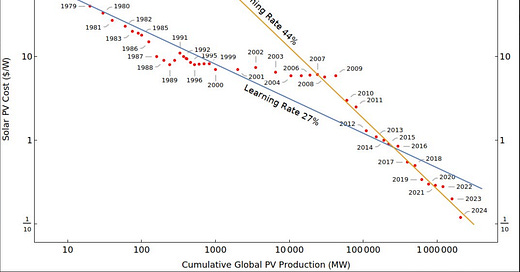Seagnal #2 - Solar modules cheaper than fences
Your weekly digest of real trends and insights amidst a sea of noise.
📊 #1 Trend - PV module cost reduction marches on
While everything in the past couple of years might have gotten more expensive, that’s definitely not the case for Photovoltaic (PV) modules. Their prices have been steadily declining, a phenomenon that will radically change our world.

The learning rate of solar, which measures the price reduction with every doubling of cumulative manufactured volume, surpasses that of most if not all other industries. With Li-ion batteries at a 20% learning rate (in $/kWh) and onshore wind technologies around 10% (in $/W), solar's impressive 27% learning rate makes it a trend to notice.
Side-note: Learning rates, while not a perfect measure, can be used as a surrogate for more complex models, keeping in mind it’s about prices and not (directly) costs (learn more).
As prices drop, the addressable market for solar widens, somewhat like semiconductor industry's evolution driven by more affordable and compact chips. This trend is evident in regions like India, where previously, high upfront costs hindered solar adoption among homeowners. Now, reduced prices coupled with government support, such as this new $10 billion in incentives for 1 to 3 kW systems, are making solar installations far more feasible in developing countries.
In Europe too, the rise of "Balcony Solar" is gaining momentum on social media and at conventions, highlighting the growing interest in a new type of solar solutions. For example Balkonsolar, a Dutch company offers a 1kW system for 1200 euros for your balcony (bypassing the need for electrician and expansive roof mounting structures).
Potential challenges, such as land availability or infrastructure costs, may arise. However, with solar becoming dirt cheap, I believe innovative applications, not limited to the residential sector, will arise transforming our landscape and reducing our carbon foot-print. So don’t discard solar because of some blockers, but rather keep in mind that historical trends tell us it will eventually cost less than fences (I could not find the learning rate of industrial fences to prove my point but you get the idea :) ).
💡 #1 Insight - There is more than one way to get to the top
Nowadays with the prevalent use of map applications, whether driving somewhere, going for a hike, or even while waiting for a taxi to pick us up, it can feel that there’s only one path to our destination.
While doing small excursions in northern India, where there are many “buffalo” tracks not yet registered, I rediscovered the pleasures of making my own way. This experience reminded me that in life there are many ways to get to your destinations or goals, and gave me some confidence in a period of personal uncertainty.
So enjoy the journey, and in time of uncertainty you might find it helpful to wander to a destination.
🔗 #3 Check these out
All Trails: Talking of maps, this one is my favorite to find good hikes.
The Innovators Dilemma: Key book on disruptive technologies, with a case study on the semiconductor industry's market expansion via hard drives.
The org: Pretty neat tool to visualise company org charts.
References:
[1] Hannah Ritchie (2021) - “The price of batteries has declined by 97% in the last three decades”. Published online at OurWorldInData.org: 'https://ourworldindata.org/battery-price-decline'
[2] The Economic Times, Cabinet approves rooftop solar subsidy scheme at an outlay of Rs 75,021 cr, https://economictimes.indiatimes.com/industry/renewables/cabinet-approves-scheme-for-installing-rooftop-solar-providing-free-electricity-of-up-to-300-units-for-1-cr-households/articleshow/108103462.cms?from=mdr



